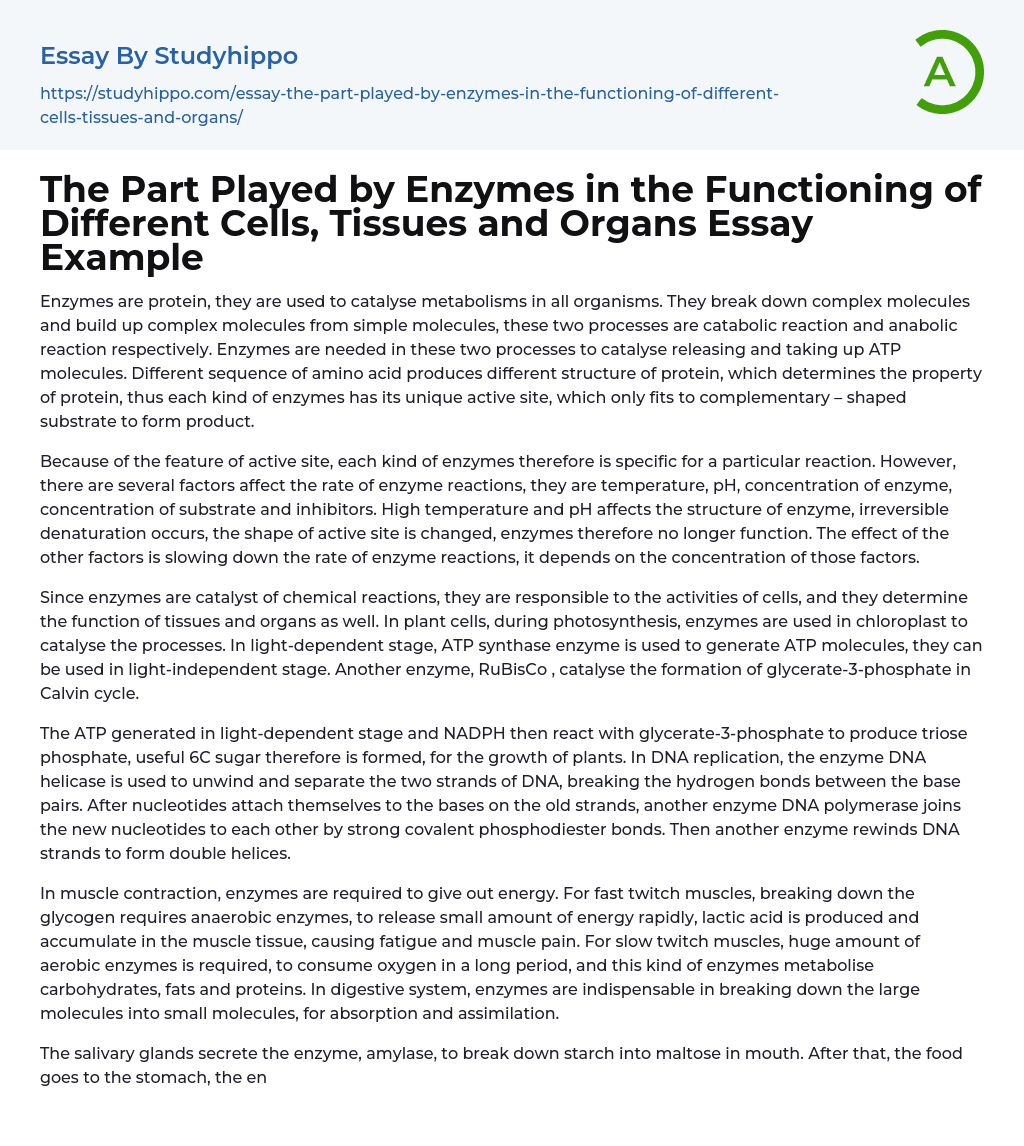

The Part Played by Enzymes in the Functioning of Different Cells, Tissues and Organs Essay Example
Because of the feature of active site, each kind of enzymes therefore is specific for a particular reaction. However, there are several factors affect the rate of enzyme reactions, they are temperature, pH, concentration of enzyme, concentration of substrate and inhibitors. High temperature and pH affects the structure of enzyme,
...irreversible denaturation occurs, the shape of active site is changed, enzymes therefore no longer function. The effect of the other factors is slowing down the rate of enzyme reactions, it depends on the concentration of those factors.
Since enzymes are catalyst of chemical reactions, they are responsible to the activities of cells, and they determine the function of tissues and organs as well. In plant cells, during photosynthesis, enzymes are used in chloroplast to catalyse the processes. In light-dependent stage, ATP synthase enzyme is used to generate ATP molecules, they can be used in light-independent stage. Another enzyme, RuBisCo , catalyse the formation of glycerate-3-phosphate in Calvin cycle.
The ATP generated in light-dependent stage and NADPH then react with glycerate-3-phosphate to produce triose phosphate, useful 6C sugar therefore is formed, for the growth of plants. In DNA replication, the enzyme
DNA helicase is used to unwind and separate the two strands of DNA, breaking the hydrogen bonds between the base pairs. After nucleotides attach themselves to the bases on the old strands, another enzyme DNA polymerase joins the new nucleotides to each other by strong covalent phosphodiester bonds. Then another enzyme rewinds DNA strands to form double helices.
In muscle contraction, enzymes are required to give out energy. For fast twitch muscles, breaking down the glycogen requires anaerobic enzymes, to release small amount of energy rapidly, lactic acid is produced and accumulate in the muscle tissue, causing fatigue and muscle pain. For slow twitch muscles, huge amount of aerobic enzymes is required, to consume oxygen in a long period, and this kind of enzymes metabolise carbohydrates, fats and proteins. In digestive system, enzymes are indispensable in breaking down the large molecules into small molecules, for absorption and assimilation.
The salivary glands secrete the enzyme, amylase, to break down starch into maltose in mouth. After that, the food goes to the stomach, the enzyme, pepsin, breaks down the protein into peptides. The food then becomes chyme, continues to be digested by these enzymes, trypsin, chymotrypsin, pancreatic lipase and amylase. The carbohydrates are degraded into monosaccharaides, proteins and peptides are degraded into amino acids, and the lipids are degraded into fatty acids and glycerol. The chyme is now able to pass into the blood vessels through the villi in small intestine by diffusion.
The enzymes function through the whole digestive system, helping us to absorb nutrients and egest the indigestive substance. In conclusion, enzymes function in every organism with different role in different cells, tissues and organs. In plant cells,
enzymes are more like catalyst, speeding up the chemical reactions. However, in DNA replication of all organisms, enzymes unwind and wind the DNA strands. In the tissues and organs, enzymes break down the large molecules into small molecules, to help speeding up the processes afterward. As a result, enzymes are essential for all organisms, they do help the growth and maintaining life and health.
- Dna essays
- Gene essays
- Bacteria essays
- Biotechnology essays
- Breeding essays
- Cell essays
- Cell Membrane essays
- Cystic Fibrosis essays
- Enzyme essays
- Human essays
- Microbiology essays
- Natural Selection essays
- Photosynthesis essays
- Plant essays
- Protein essays
- Stem Cell essays
- Viruses essays
- Anorexia essays
- Breakfast essays
- Caffeine essays
- Chewing gum essays
- Child Development essays
- Chocolate essays
- Diet essays
- Dieting essays
- Eating essays
- Eating Habits essays
- Energy Drink essays
- Food essays
- Genetically Modified Food essays
- Genetically Modified Organisms essays
- Junk Food essays
- Metabolism essays
- Milk essays
- vegetarian essays
- Vitamin essays
- Weight Loss essays



